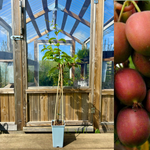Subscribe and save 10%!

Minikiwi 'Geneva' Female plant 50-60 cm (Actinidia arguta)
325 SEK
Unit price perExpected delivery date: 21 December to 28 December.
Applies to orders within Sweden. For other countries - see our delivery terms .
In stock - Ready to be shipped
Share
325 SEK
Unit price per1st plant Minikiwi 'Geneva': 2 years old - current height 50-60 cm
Non-self-fertile female plant = needs a male plant that 'Weiki' or a bisexual self-fertile variety such as 'Issai' to bear fruit. A pure male plant is recommended for best fruiting.
Common names: Minikiwi, Gooseberry, Hardy Kiwi
Scientific name: Actinidia arguta
Family: Actinidiaceae
Plant history & use:
Minikiwi is a perennial climbing plant that originates in Japan, Korea and northern China. It is a hardy Kiwi variety that can grow and produce good fruit outdoors in our climate. The fruits are small and hairless, and are eaten with the skin on, unlike the hairy kiwifruit we are used to buying in stores.
The variety 'Geneva' is an American variety found growing near Hedrick Hall at the Cornell Experiment Station in Geneva, New York. The variety is hardy to at least -25℃ and produces smooth, very sweet fruits with reddish skin.
The 'Geneva' variety is a female plant and needs either a male plant or a hermaphrodite plant, such as the 'Issai' variety , nearby for pollination.
The fruits are a rich source of vitamin C (up to 5 times more than blackcurrants, for example) and can be eaten straight from the plant without peeling. The fruits can also be used to make jam.
In Korea, young leaves are used in a vegetable dish called namul.
Culture:
Mini kiwi 'Geneva' is a hardy variety that can withstand temperatures down to -25 ℃ . It has a winding growth habit and can grow up to 3-4 meters high. Some type of climbing support is necessary, such as a trellis, wall or pergola. If you want to grow in a forest garden, it works great to let Minikiwn grow against a tree trunk - just try to make sure there is reasonably good light entering the plant.
In June-July, 'Geneva' blooms with small, fragrant white flowers that then turn into tasty, smooth small fruits. The summer green leaves turn a beautiful yellow in the fall.
The variety 'Geneva' usually produces fruit in the second year after planting. An established plant can produce large quantities of fruit per year, around 25kg per plant and in some cases more.
Mini kiwi thrives best in a sunny, warm and sheltered location. The optimal growing location is in a greenhouse, against a wall or trellis. However, it also does well outside greenhouses and in shadier environments - but for best fruit production, the plant should at least be provided with good light and wind protection.
Plant Minikiwi in a nutrient-rich, well-drained and moisture-retaining soil. If you want to fertilize, it should be done with, for example, blueberry fertilizer, as Minikiwi thrives best in a slightly acidic pH. Natural fertilizer and compost also work well.
It is advantageous to grow against a trellis to get good air circulation and more sunlight for the fruits.
Pruning when trellising:
- The first year of planting, it is a good idea to let the plant start to take shape in 1-3 main stems. Top your main stem(s) at the end of the season to make them stronger next year.
- The second year you top the main shoots that come from the main trunks again. The side branches, or long shoots, then begin to develop. You should stick to a maximum of 4 long shoots per main trunk.
- In the third year, the long shoots should also be shortened to 1-1.5 meters. At this time, flowers often begin to form around the first few centimeters of the side branches, which then turn into fine fruits.
- In the following years, year by year, you select the best side branches/long shoots on your plant. Cut away the other emerging branches. In this way, you have formed a star-shaped branch attachment, a collar, which supports the rest of the plant with fruits.
- Do not leave too many side branches as this will result in a dense plant with fewer fruits. By topping emerging herbaceous branches during the summer you allow more sunlight and air to reach the fruits, which will benefit their growth.
- Any pruning of woody plant parts is done in late autumn/early winter to avoid bleeding.
Features:
Year: Perennial
Growing position: sun
Height: 3-4 m
Growing zone: 1-5
- Choosing a selection results in a full page refresh.
- Opens in a new window.




